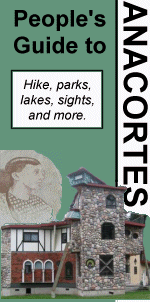Wrestling With Wealth Inequality In The Gambia
| Almost anyone who has traveled to a developing nation has likely been confronted with the glaring wealth inequality between the US and wherever they are traveling. It is evident in so many ways: poor infrastructure, unavailability of goods and services, interactions with everyday people, and so much more. And while wealth inequality is evident in the US too, it somehow feels much more prevalent in so many countries I've visited.
Take The Gambia: according to a recent article in Global Finance Magazine, The Gambia ranks as the 16th poorest country in the world, even poorer than Haiti and Sudan. The U.S. is 7th richest with almost 30 times more per person, based on GDP and purchasing power parity. When you factor in the severe drop in tourism due to COVID-19, it puts a country that has not an insignificant reliance on tourism like The Gambia in an even tougher position. 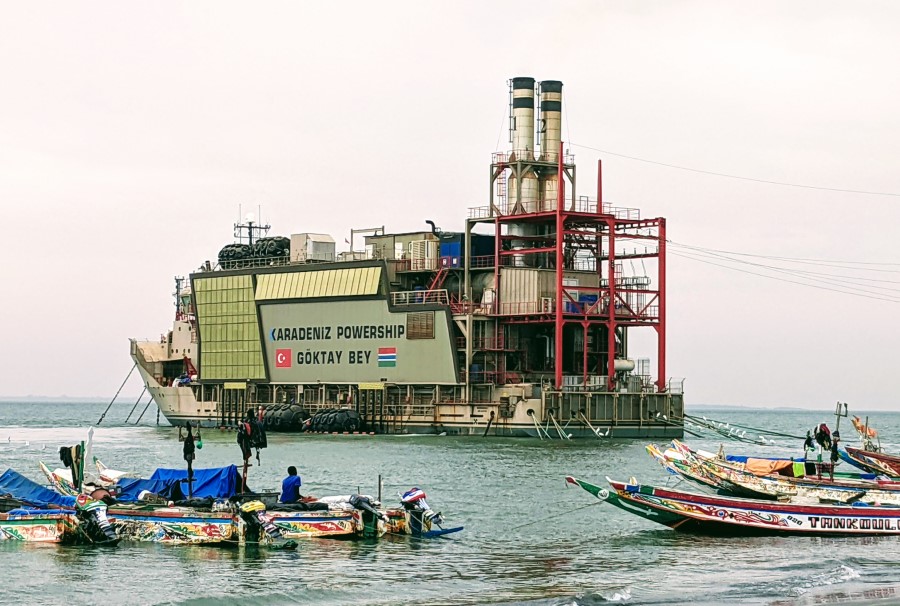
A Turkish power generation boat serves electricity to much of coastal Gambia because the local infrastructure is under developed. This wealth inequality was one of the factors that help me choose where I'm going to travel to. Hawaii doesn't need my money. Nor, in the recent case of me needing a rest after the Camino, does Ibiza or the Canary Islands. I figured while although the travels of Wren don't equal status quo changing amounts, every dollar I spend in a place like the Gambia or Senegal (34th poorest nation) is a dollar that otherwise wouldn't get added to the economy. And yes, not every penny of that dollar (or every butut of that dalasi, as the case may be) stays here (I do occasionally buy a snickers, Coke, or other American product in a pinch), but I figure a non-zero amount makes it into the hands of a Gambian and that I count as a win. So it is with all this in the back of my head that I toddle along on my African journey. I try my best to eat at local restaurants, stay at hotels/guesthouses that are owned by a person not a corporation, and not over-haggle. And even though it is counter to the habits I've spent a lifetime forming, I try to use the wealth inequality argument to splurge a little, maybe a couple fresh juices here or a cab ride instead of bus there. 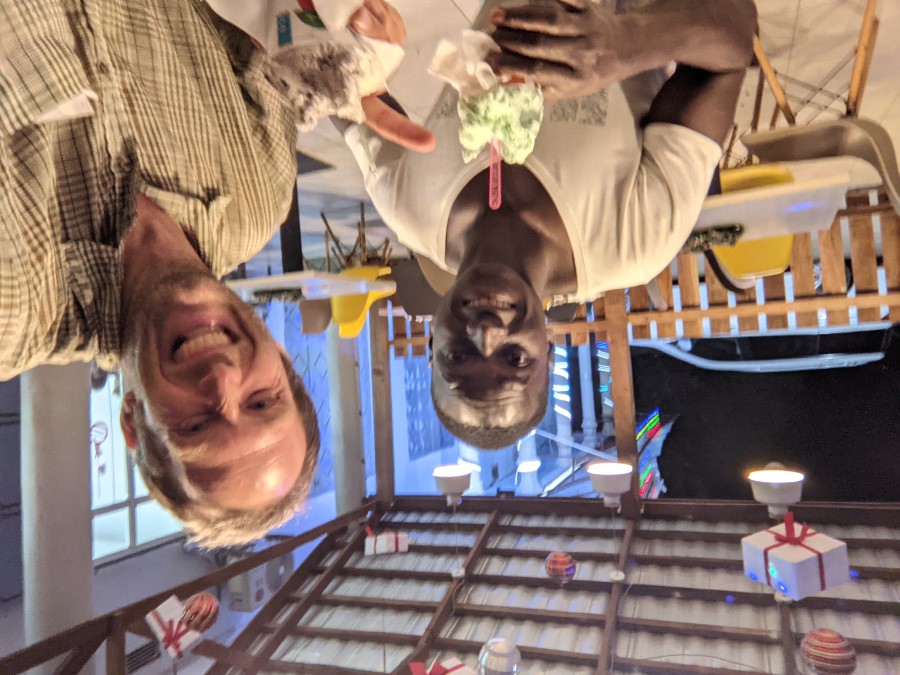
Enza and me with some delicious ice cream from Ice Land. In the last couple days, however, this consideration has come to the foreground. My daily routine involves quite a bit of walking and on these walks, I'm always approached by tour guides, taxi drivers, or market stall owners asking for my business. Since I'm rarely in need of their services, I instead take some time to answer their questions* and generally try to change the interaction from one of me feeling looked upon as a possible sale and little more to one where we are two people having a genuine conversation. It works maybe half the time. When it works, however, it can lead to some really great moments. The Gambian people are super nice. They don't call it the Smiling Coast for no reason. So I've had some really nice conversations, often hearing about the toll the pandemic is taking on people's lives and livelihoods. Last night, as I meandered the town looking for some dessert, a shop owner fell in beside me with the usual. After sharing a bit about an earlier negative experience I had with a local tour guide hustler, our interaction transitioned to a truly genuine one. He told me a lot about his life and esp. the finances of it (how much a bag of rice has gone up since the new president took power, how much it costs to send his brothers and sisters to school, how much medicine can cost when you get sick, how it is his job to support his mother and family yet he goes days without a sale at his shop). He ended up joining me the whole 2 mile walk to the ice cream shop where we continued our conversation the good stuff. On the way home, he introduced me to his mother. It was nice. I plan to swing by his shop later to at least have a look. 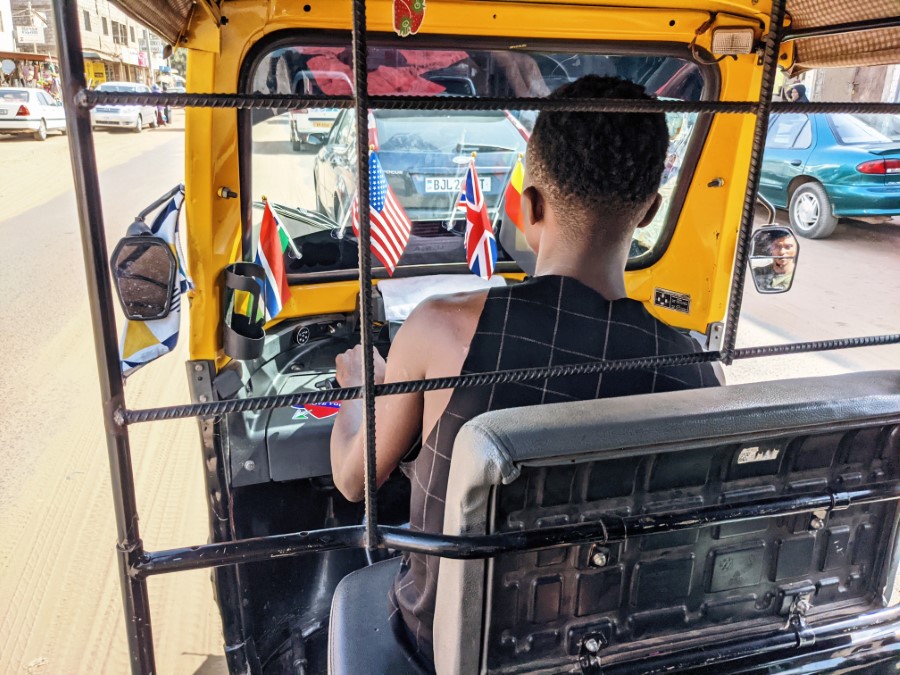
I always love riding in a tuk-tuk, even if I could have just as easily walked. I wish I had some greater revelation re: this issue of wealth inequality viewed through the lens of travel besides hoping my meager travel budget is a drop in the bucket of what's needed. And I guess the mere act of being here and having my eyes further opened to the realities of that wealth inequality is something, esp. as it will be part of the story I tell about my time here. But with only <2 days left until I leave, perhaps I should just post this and head out and try and spend a bit more money. There's a fresh juice stand on the beach calling my name. |
| Wednesday December 22 2021 | File under: travel, Gambia |
| comment? |
A Gambian Meal
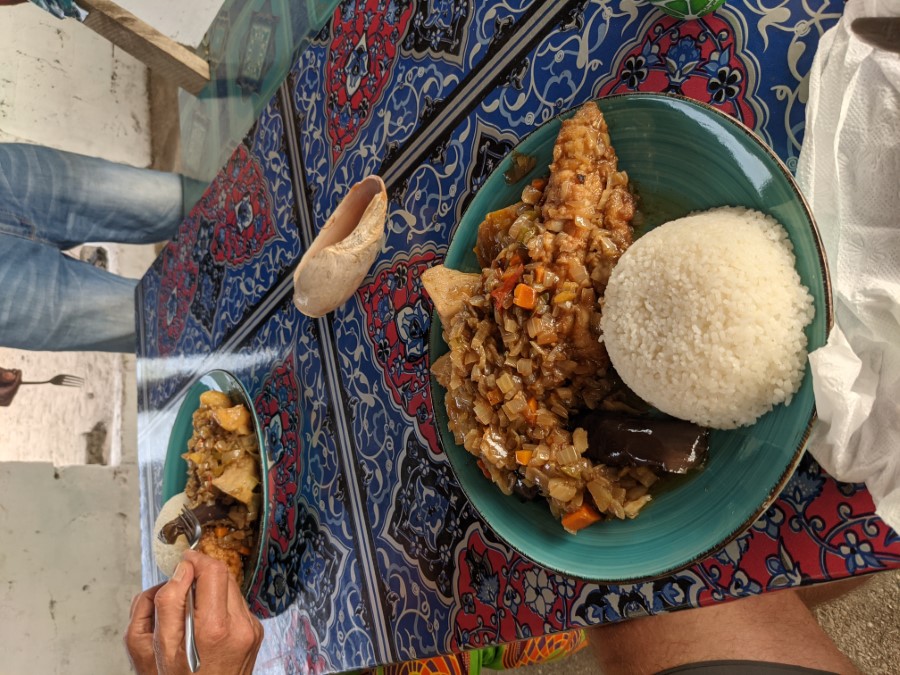 With the thought that a little down time might not hurt, I decided my first days in Gambia might call for a beach and, well, little else. I found a nice "eco-lodge"* where the price was right. Tourism is very low, due to COVID, so I practically have the place to myself. With the thought that a little down time might not hurt, I decided my first days in Gambia might call for a beach and, well, little else. I found a nice "eco-lodge"* where the price was right. Tourism is very low, due to COVID, so I practically have the place to myself.
And while I'm looking for down time, I don't want it to be boring, so when an ex-pat who is living here asked if I wanted to accompany her on an "adventure", I was totally game. I needed to go into the little town anyway to exchange money*. So off we went in the bush taxi. The plan, as I understood it, was to hook up with a local beach bar owner friend, visit the market and get some stuff for a meal, convince beach bar owner to cook said meal, and generally make a day of it. And a day of it, it was. Nothing in Gambia (or Senegal, for that matter) seems to move with any sense of urgency/speed/seeming purpose, so I was very prepared for the meandering, side quests, distractions, and more that made our trip to the market take 2-ish hours. And when I mean market, I don't mean grocery store. The little fishing village near Gunjur was a mishmash of ramshackle huts, each selling a little of this or that. We got onions here, tomatoes there, rice bread water there there and there. I say "we" but I just happily tagged along while Lamin and Antje chatted our way through and handled the business. I was just along for the ride. The focus of the meal was to be butter fish, a step up, as I understand it, from the standard fish that seem to exist in piles all over. So we found a place cutting it fresh (though a million miles from hygenically) and grabbed some fillets. And with that, we were off down the beach! Lamin's beach bar was, well, sparse. No electricity, no floor, thatched roof, and cooking that happened over a fire out back, as far as I could tell. But it was right on the beach and really really peaceful. The cooking was another unhurried event, taking more than 2 hours. While we waited, I entertained the locals who were hanging out with some juggling, having found a machete and a couple of kitchen knives. They were a great audience. When dinner was served, it was, well, authentic. Carrots, sweet potatoes, taro, egg plant, tomatoes, cabbage, onions all coated in oil and slow cooked. The fish was battered and fried. And off it was served with white rice. The plate was so full I could barely finish it (thought left a bit of the smooshy eggplant). All in all, the food was good, though not great. Definitely a good boost of veggies that my diet has been sorely lacking*. The experience, however, was top notch. I got a local experience and down time, really exact what the doctor ordered. Back at the hotel, I entertained a staff with my rope tricks. Talk about the best audience ever! They all wanted to learn all of them and I was happy to oblige! |
| Friday December 17 2021 | File under: travel, Gambia |
| comment? |
Three Short Stories From Senegal
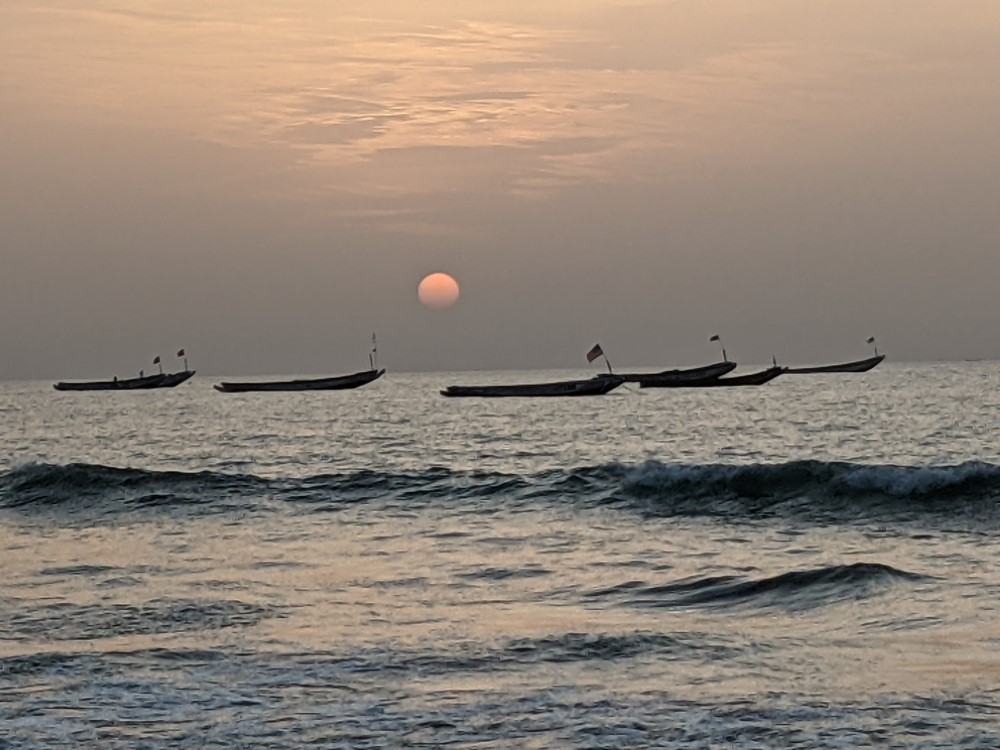 Story #1: What Are Borders Anyway? Story #1: What Are Borders Anyway?
On the topic of travel, people often ask "What countries have you been to?" Besides relishing the question as a lowkey way to brag, I also love to tell the story of the time I snuck under a barb-wire fence to get my picture in Russia! Well, I did it again...I think. Cap Skirring, Senegal is in the far Southwestern corner of the country. In dinking around with google maps, I realized I was less than 1 mile from the border of Guinea-Bissau. Why not? So I struck off down the beach (coming up on sunset a little sooner than I had bargained for). All in all, it was even more anti-climactic than the Russia barbed-wire thing. There wasn't a fence or anything. I just walked until my phone said I was in Guinea-Bissau then turned around and headed home (so as not be be stuck in the dark.) Do I feel like I've been to Guinea-Bissau? No. But will it be a fun asterisk when the topic comes up? Heck yeah! Story #2: Little Successes of Public Transportation 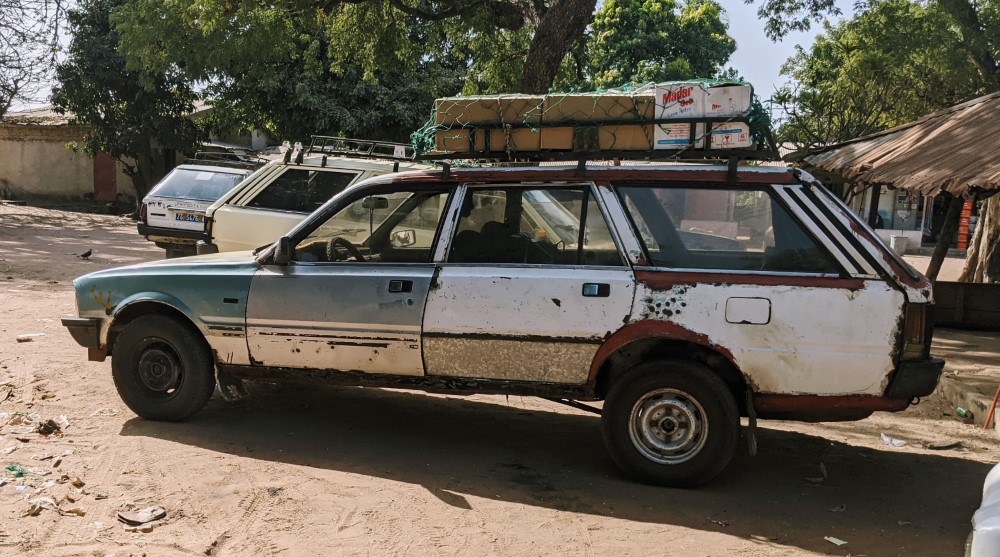 One of the things I really like to do when traveling to a new place is to get to know how the locals get around. Sure I could take a taxi everywhere (assuming I can somehow communication where I want to go), but that feels like cheating, like going to a foreign land and staying in the resort the whole time. Here in Senegal, the way people get around the sept place, these beater old cars (all the same model of Pugeot) that take 7 passengers crammed together down the potholed roads. They don't have any schedule, just leave once they are full. But despite the absolute chaos of the sept place station, there is a method to the madness, or so it seems, as I have ended up where I wanted to go all three times I've tried! Successfully getting around the way the locals do feels like a little success, but an important one, one that I can feel proud of. (But that pride doesn't keep my butt from falling asleep when crammed in the way way back of that little Subaru-sized thing.) One of the things I really like to do when traveling to a new place is to get to know how the locals get around. Sure I could take a taxi everywhere (assuming I can somehow communication where I want to go), but that feels like cheating, like going to a foreign land and staying in the resort the whole time. Here in Senegal, the way people get around the sept place, these beater old cars (all the same model of Pugeot) that take 7 passengers crammed together down the potholed roads. They don't have any schedule, just leave once they are full. But despite the absolute chaos of the sept place station, there is a method to the madness, or so it seems, as I have ended up where I wanted to go all three times I've tried! Successfully getting around the way the locals do feels like a little success, but an important one, one that I can feel proud of. (But that pride doesn't keep my butt from falling asleep when crammed in the way way back of that little Subaru-sized thing.)
Story #3: A Bad Day Turned Around As you may have gleaned from my last post about communication, Senegal has not been the happy-go-lucky recovery adventure I was naively hoping for. I keep hoping that each day will be the start of a that adventure, just after I learn how to do this, say that, or understand the other thing. Today, I prepared for that new start and came up with a plan. I sought 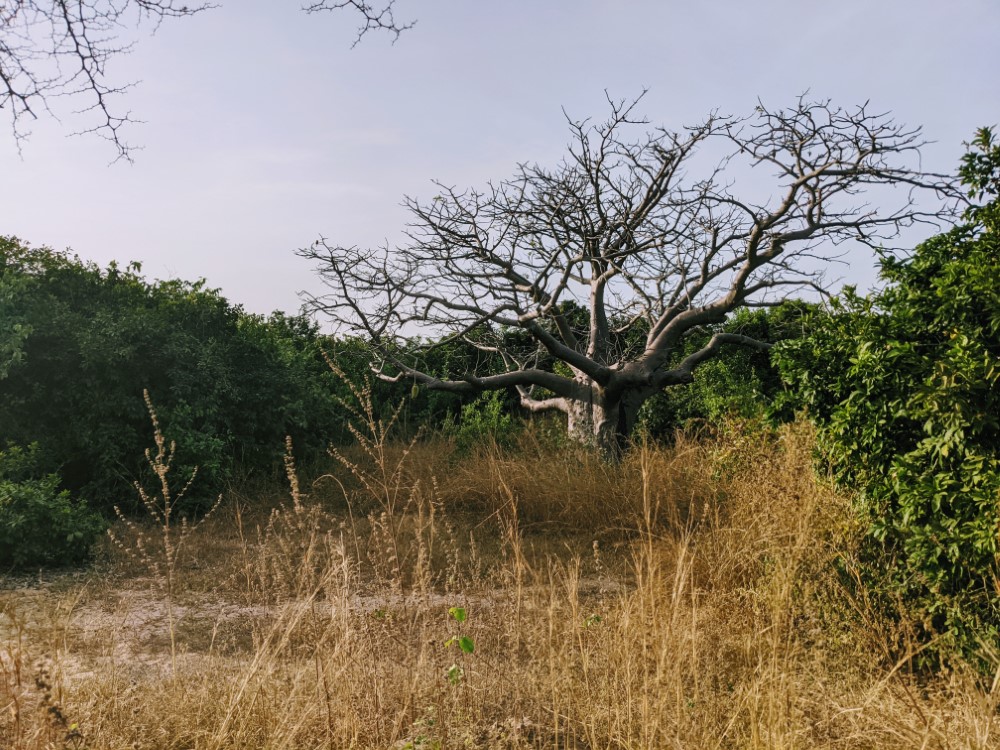 out the one English speaker I had found in Cap Skirring, a great Rasta guy that ran a little cafe. I asked him advice on where to go, what to do, how to get there, and more. He was so helpful! He talked me out of one place I was going to go and into another one that he said was much nicer, cheaper, etc. He even hooked me up with his friend, supposedly English speaking, so when I arrived, he could help me find a good hotel and navigate the town. Well, after a fiasco of an entourage of moto-taxis, nearly spilling on the streets made of sand, and further communication gaps, I find myself stuck having to stay at possibly the worst hotel I've stayed in (which is really saying something) for a rate that could have gotten me at least a beach hovel in the previous town. I was so frustrated with the whole situation that I swore a blue streak (after everyone had left). out the one English speaker I had found in Cap Skirring, a great Rasta guy that ran a little cafe. I asked him advice on where to go, what to do, how to get there, and more. He was so helpful! He talked me out of one place I was going to go and into another one that he said was much nicer, cheaper, etc. He even hooked me up with his friend, supposedly English speaking, so when I arrived, he could help me find a good hotel and navigate the town. Well, after a fiasco of an entourage of moto-taxis, nearly spilling on the streets made of sand, and further communication gaps, I find myself stuck having to stay at possibly the worst hotel I've stayed in (which is really saying something) for a rate that could have gotten me at least a beach hovel in the previous town. I was so frustrated with the whole situation that I swore a blue streak (after everyone had left).
The one savior of where I ended up was that one of the few Senegalese geocaches was a mere hour walk away. In hopes of cheering myself up, I set off. Alas, like the other two caches I tried in Dakar and almost everything else in this country, I was thwarted. But 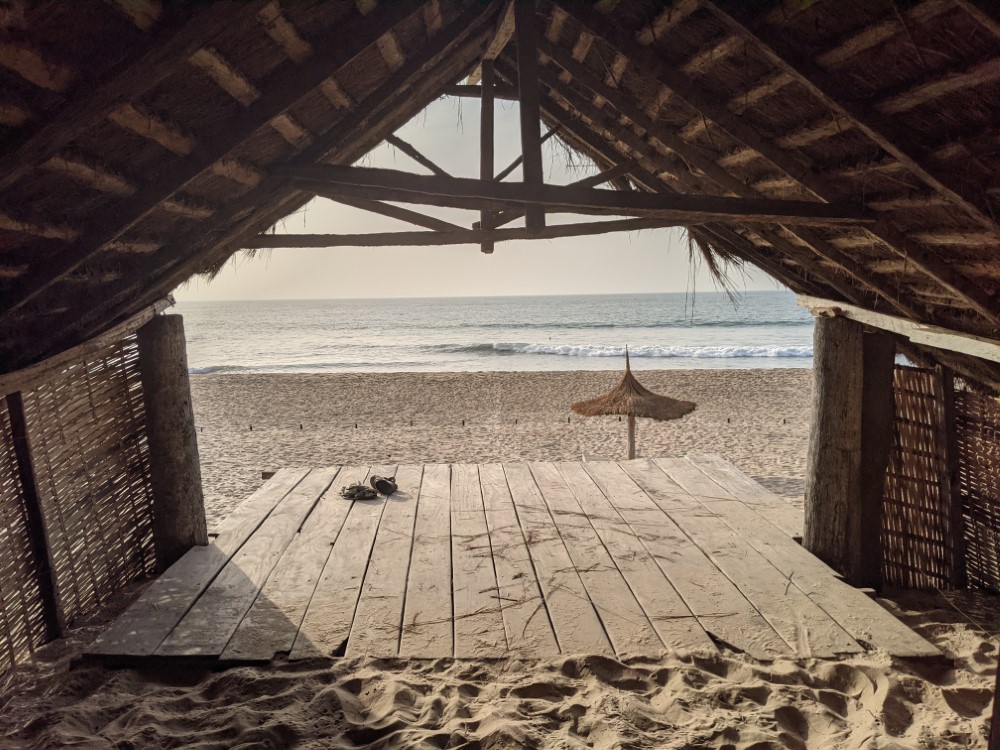 as is the point of geocaching, it took me to a spectacular location. And after a bit of letting the funk of the day wash away, I started to appreciate it: a beautiful secluded beach with wonderful thatched hut, an incredible hotel/bar property full of giant baobob trees, lagoons, and more (which I, coincidently, booked myself at for tomorrow night), the sunset, the walk back along the beach to a lively beach fish market scene. By the time I arrived back at my cell of a hotel room, I had found my peace, at least for the day. Did this turned around day balance out the contentious relationship I've had so far with Senegal? No. But I'm hoping it might be a start. as is the point of geocaching, it took me to a spectacular location. And after a bit of letting the funk of the day wash away, I started to appreciate it: a beautiful secluded beach with wonderful thatched hut, an incredible hotel/bar property full of giant baobob trees, lagoons, and more (which I, coincidently, booked myself at for tomorrow night), the sunset, the walk back along the beach to a lively beach fish market scene. By the time I arrived back at my cell of a hotel room, I had found my peace, at least for the day. Did this turned around day balance out the contentious relationship I've had so far with Senegal? No. But I'm hoping it might be a start. |
| Monday December 13 2021 | File under: travel, Senegal |
| comment? |
Lost In Translation In Senegal
 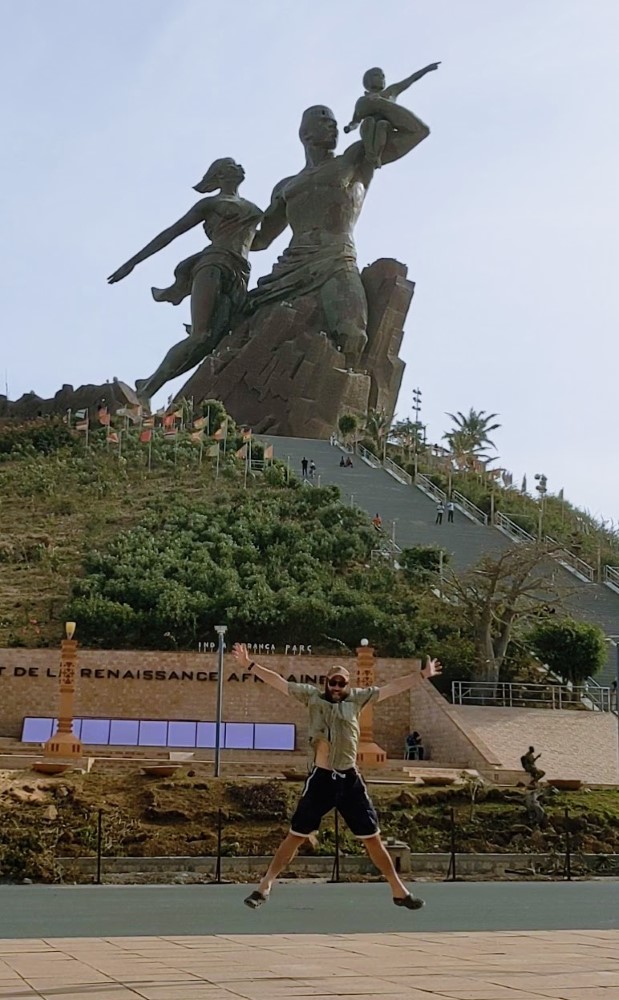 First off, there's the French thing. Not only do I not speak it, I can't even pronounce it when I see it written*. So much for google translate to the rescue. And since most of the foreign tourists here do speak French, most locals assume I can understand them and am probably just being a jerk. But aside for awkward interactions, not being able to communicate affects things: can't communicate to a cab driver where I need to go, can't get a price for, well, anything, can't understand that the boat I'm getting on isn't headed to where I think it's headed to. Some of these things are par for the traveling course. And it's not something I've never dealt with, but what compounds it is... First off, there's the French thing. Not only do I not speak it, I can't even pronounce it when I see it written*. So much for google translate to the rescue. And since most of the foreign tourists here do speak French, most locals assume I can understand them and am probably just being a jerk. But aside for awkward interactions, not being able to communicate affects things: can't communicate to a cab driver where I need to go, can't get a price for, well, anything, can't understand that the boat I'm getting on isn't headed to where I think it's headed to. Some of these things are par for the traveling course. And it's not something I've never dealt with, but what compounds it is...
All the tools I rely on also seem to be suffering clear communication issues, though this time not based on language. The guidebook I'm using (most current version, only 3-4 years old) still referenced the old airport (a $40 cab ride away). Google maps is atrociously wrong, both on where roads exist and where hotels and establishments are on them. Even the most current info for the overnight ferry got a bunch of stuff wrong, specifically that there would be beds (there weren't) and that it would make a stop before its final destination (which it didn't.) Luckily, despite these frustrations, I've had some good experiences. Those that do speak English (few and far between) have been super happy to practice with me. And even when I respond to a "ça va??" on the street with a thumbs up, I get a smile in return. Too bad I can't communicate "to the nearest ice cream stand, stat!" with a smile. So while the communication thing has proven much harder than anticipated, I'm getting along, as I do. I added a jumping photo to my ever growing collection*. I've got to squish sand through my toes and let the Atlantic wash it away. I've eaten some great food (until I was laid up with a bad case of the Timbuk-toots). I've seen oodles of dolphins. And, as was my goal, I'm here and getting to know Senegal, even just a little bit. Perhaps this language thing will become too much for me and I'll hightail it for the English-speaking The Gambia. Or maybe I'll get over my need to understand and be fine with paying whatever they want to charge a bottle of water or a kebab of shrimp or the ability to take your luggage with you in a shared taxi. Ha ha. Just kidding. The Gambia here I come... |
| Saturday December 11 2021 | File under: travel, Senegal |
| comment? |
Camino Wrap-Up
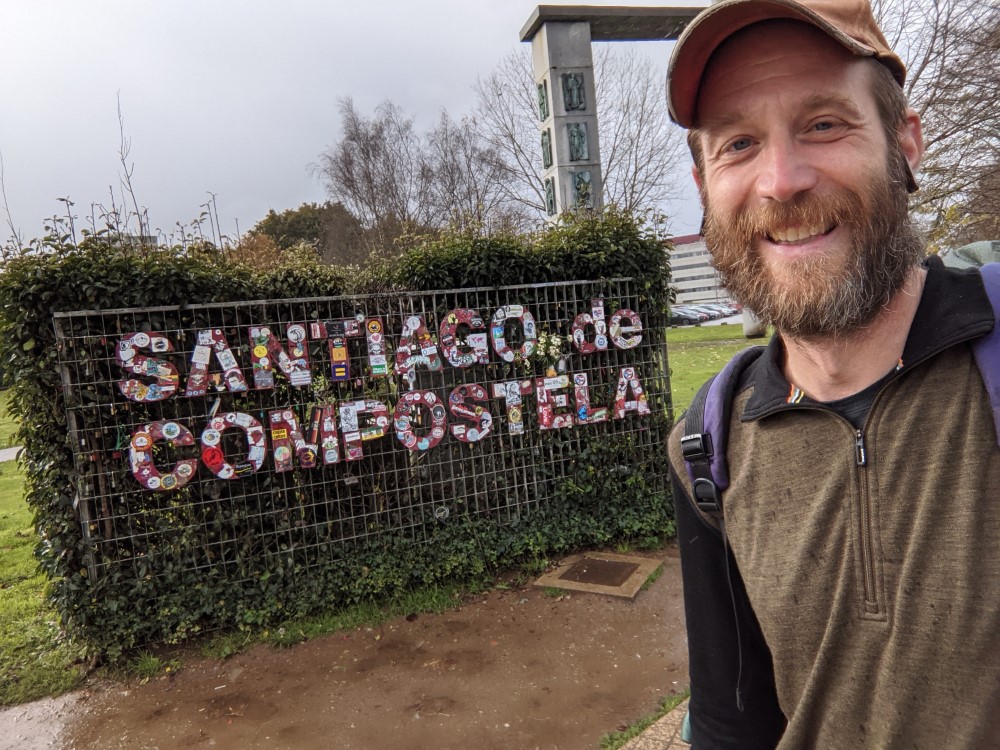 Well, I did it. I completed the Camino de Santiago. Specifically, I walked the Camino Frances (French Way) from St-Jean-Pied-a-Port, France to Santiago de Compostela, Spain. Guide books and mileage markers put the distance at 490 miles, but with detours, exploration, and occasionally getting a little lost, my mileage came in closer to ~520. It took me 30 days without any rest days, averaging a little over 17 miles a day. Well, I did it. I completed the Camino de Santiago. Specifically, I walked the Camino Frances (French Way) from St-Jean-Pied-a-Port, France to Santiago de Compostela, Spain. Guide books and mileage markers put the distance at 490 miles, but with detours, exploration, and occasionally getting a little lost, my mileage came in closer to ~520. It took me 30 days without any rest days, averaging a little over 17 miles a day.
I kept a daily journal of the trip, available here*, but I wanted to summarize and capture some overarching observations and feelings.
In conclusion, I walked 500 miles*. It was an experience I will never forget (for so many reasons) and I'm really glad I did it. To see a gallery of the three photos I challenged myself to take everyday, click here and arrow right. . . . . . . . . . . . . . . . . . . . . . . . . . . . . . . . . . . . . . . . . . . . . . . . . . . . . . . . . . . . . . . . . . . . . . . . . . . . . . . . . . . . . . . . . . . |
| Sunday December 5 2021 | File under: travel, Spain |
| Toggle Comments (4) | comment? |
Camino de Santiago Trail Journal
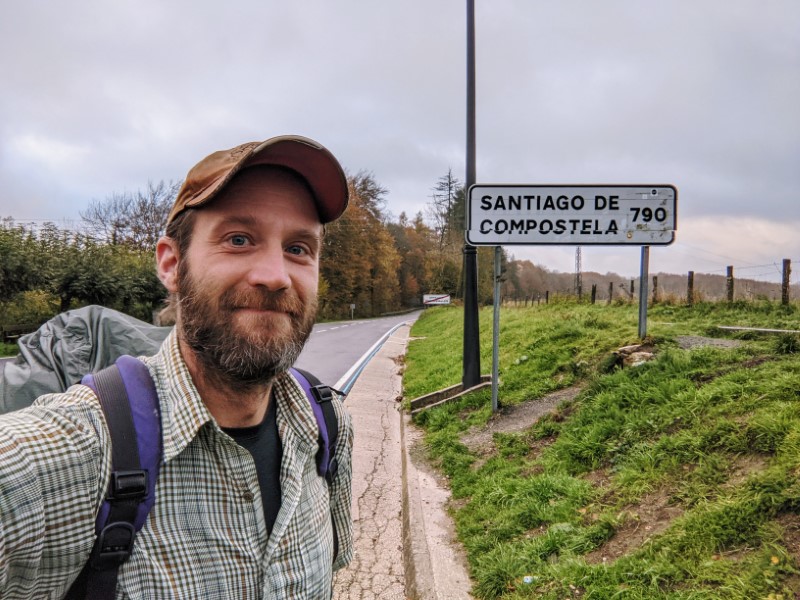 I'm walking the Camino de Santiago in northern Spain. Minimal research and planning speculate it will be about 500 miles and about 30 days. My minimal planning, however, has allowed for maximum flexibility, though, so we'll see. I'm walking the Camino de Santiago in northern Spain. Minimal research and planning speculate it will be about 500 miles and about 30 days. My minimal planning, however, has allowed for maximum flexibility, though, so we'll see.
Instead of making blog posts to track the adventure*, I've decided to keep a sort of trail journal. As with almost all things BdW, it will mostly be for me and my buddy posterity, but I offer it below in case you'd like to follow along. (The iframe below will be a window the to the live document, so scroll to the bottom to get the latest. Or you can just go here and bookmark it.) I'm imagining the journal will be as much about data-keeping as it will be about reflection (in true Wren style), so don't expect any Hemmingway-esque prose. (Oh, and as with most journaling, spelling and grammar errors don't count.) In the spirit of data-keeping, here are a few nuggets: * Pre-trip weigh in: 193.9 (high code orange, but I let myself off the hook for the weeks before as I knew I might shed a few lbs walking.) * Pack weight: ~25lbs, depending on what I'm wearing vs. carrying, how much water I'm carrying, etc. * Money spent on gear: $200 rain jacket, $25 used rain pants, $25 used light-weight sleeping bag, $40 backpack rain cover, $10 used insulated 1/2 liter water bottle for carrying tea So let the adventure begin. |
| Friday November 5 2021 | File under: travel |
| Toggle Comments (15) | comment? |
Money Map
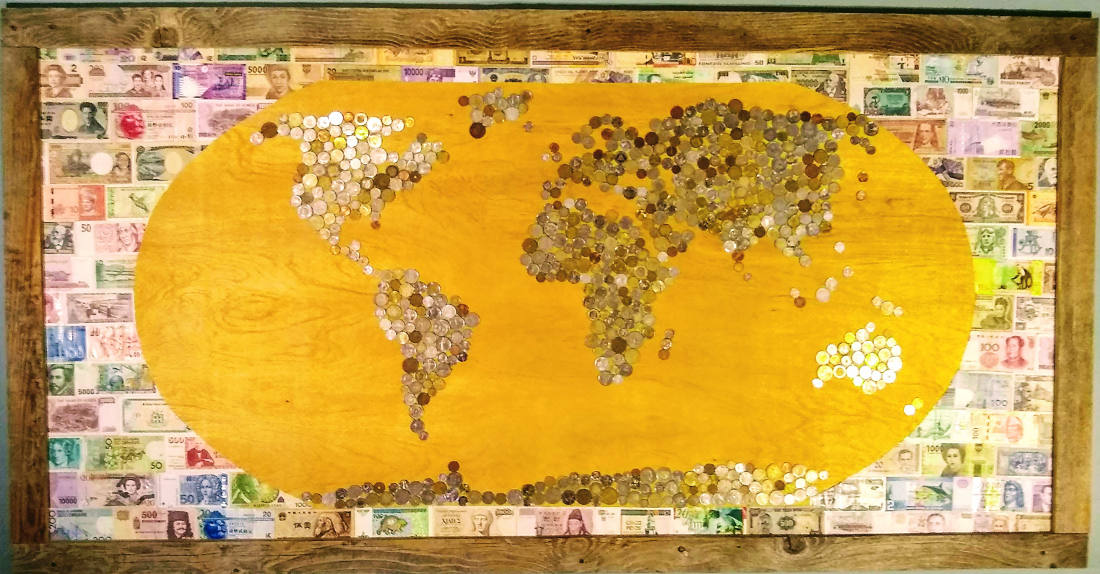 Thanks to the time freed up by having all my work and adventures cancelled by quarantine, I've completed another long-overdue project! I've been dreaming and scheming of this money map for well over a decade. Every country I travel to*, I try to come home with one of each of the coins and bills under, say, $10. It's often the only souvenir I end up with. And over the past decade plus, I've built up quite a collection. Before you ask, no, each country isn't made up only with coins from that country. I considered that, but logistically, it just doesn't make sense. Panama and Costa Rica together can only fit one small coin while Russia and China would have tons of repeat coins. It was hard enough deciding what to do with narrow land masses that were fractions of a coin wide. (Malay Peninsula, I'm sorry.) It broke my heart to cut the paper money to make the shapes, but I consoled myself knowing that the money is either outdated, of so little value that it's no big deal, or that I won't likely return to the country to use to it*. Even so, there's well over the equivalent of $100 used which makes it maybe the most expensive piece of art I own. This thing is not small, either. It is over 6 feet wide (obligatory artist with his creation shot for scale), partially to help deal with those pesky narrow land masses and small islands. And getting the coins to stick in place was a bear. I fully expect to awake to the plink plink of falling coins some night not too far off. But overall, I'm inordinately pleased with how it turned out, and that I finally got around to completing a project that's been in my head for so long. Admiring at all the money while creating it and remembering the stories attached to each place was a great balance to the backache that came from being hunched over, gluing for hours at a time. Really, I don't think I could conceive of a piece of art better suited to my interest: travel and money. Sure, maybe I could throw in the equator made of gummi bears, but that's how you get ants. What will the next long-overdue quarantine art project be? Check back in 5 months to find out! P.S. If destroying money is illegal, I'm sorry. And I've got a lot of countries I better not show my face in again. Here's hoping the Governor of the Netherlands Antilles isn't an avid BdW reader. |
| Saturday September 5 2020 | File under: travel, misc |
| Toggle Comments (1) | comment? |
Financial Recap of Singapore-Malaysia-Indonesia
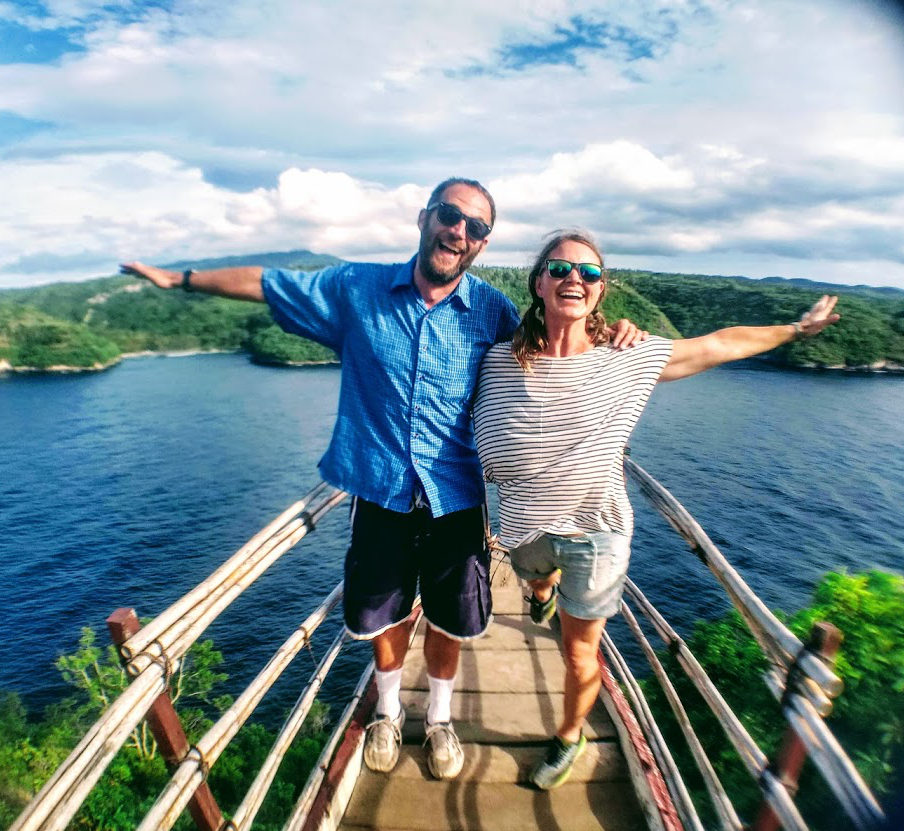 At the end of any travel adventure, after the stacks of mail have been dealt with, the clothes have been washed, and the tans start to fade, Della and I like to recap how the money side of the trip panned out to a) help contextualize it b) log it away to help inform the next trip and c) to bask in the awesome memories a little bit longer. This trip to Singapore/Malaysia/Indonesia was the longest, most ambitious, and most expensive trip we've taken, which in my eyes just means MORE DATA! At the end of any travel adventure, after the stacks of mail have been dealt with, the clothes have been washed, and the tans start to fade, Della and I like to recap how the money side of the trip panned out to a) help contextualize it b) log it away to help inform the next trip and c) to bask in the awesome memories a little bit longer. This trip to Singapore/Malaysia/Indonesia was the longest, most ambitious, and most expensive trip we've taken, which in my eyes just means MORE DATA!
After transferring the data from our travel journal to a spreadsheet and categorizing it, this is what it looks like.
A few random money observations along the way:
| |||||||||||||||||||||||||||
| Sunday March 15 2020 | File under: travel |
| comment? |
Grab and Gojek - A Ray of Light in the Otherwise Dismal Transportation Scene in Bali
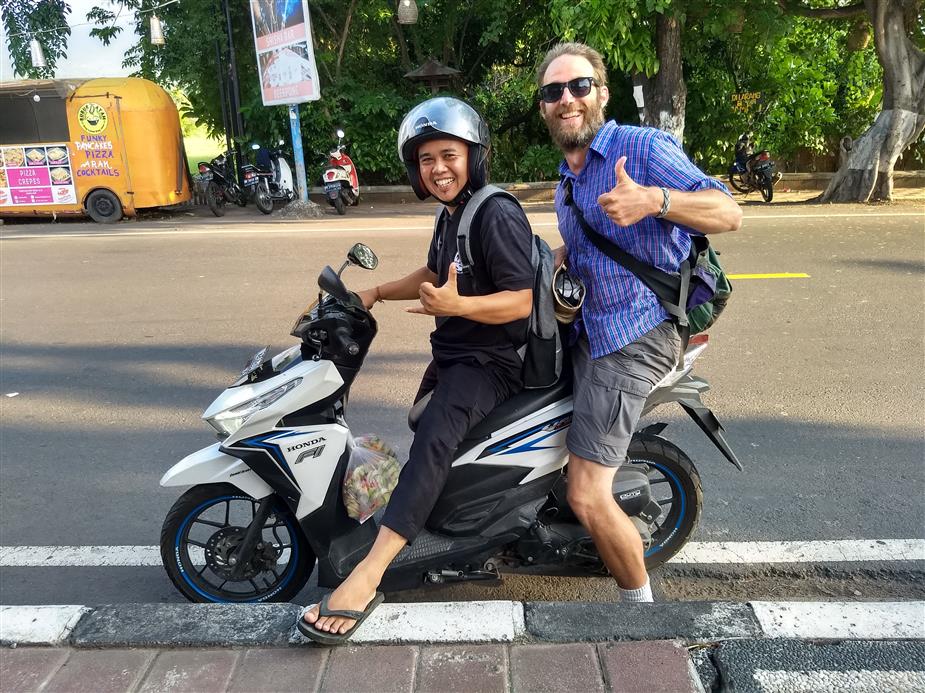 Transportation in Bali, at least from the perspective of this budget traveler, is severely broken. Compared to the trains, subways, public buses, ferries, and more of the rest of our trip, travel was so much of a bummer that for mostly this reason, we will have a hard time recommending Bali to prospective travelers. Transportation in Bali, at least from the perspective of this budget traveler, is severely broken. Compared to the trains, subways, public buses, ferries, and more of the rest of our trip, travel was so much of a bummer that for mostly this reason, we will have a hard time recommending Bali to prospective travelers.
Don't get me wrong: we saw some really cool stuff. There were oodles of seclude waterfalls, myriad gorgeous rice terraces, innumerable friendly people, countless cute monkeys, delicious food and drink, a really really tall statue, and more. But getting to each of said places was a challenge (and not the good kind of challenge where you feel like you accomplished something afterward, but more like the kind of challenge you might euphemistically call talking to your Trump-supporting uncle about politics.) Bali's epic fail of a transportation scene is an open secret. The roads are overcrowded and sometimes downright scary due to poor infrastructure investment; the public transportation system that was once in place has pretty much ceased due to all locals now owning their own scooter; the taxi system has been called a "mafia" where prices are monopolistically high and the aggressiveness of the drivers is nerve-rattling; and renting a scooter, while an attractive option, comes with a risk of playing into police bribery*. Most travel guides suggest hiring a driver and private car to take you around to the various sites, but besides costing more than our total daily budget, this option felt just too chauffer-ish. Enter Grab and Gojek, Asia's answer to Uber and Lyft. Prices are very reasonable and clearly communicated, the drivers never once failed to be friendly, miscommunication is rare since you select destination via the app, and the cars were all airconditioned*. While private ride-share takes away from the travel experience, separating us off in our own little bubble, it was pretty nice when it worked. But many areas ban Grab and Gojek* while others were so remote, there weren't any drivers around. So what do you do in the absence of good transportation options? We got creative. We rented bikes and took to the back roads. We bummed a ride with the every so friendly locals. We walked...a lot. And, unfortunately, we did less than we would have otherwise. Temples went unseen, beaches went unswam, and chocolate plantations went ungrazed. If we get a chance to tell you about our epic 2-month Singapore/Malaysia/Indonesia celebration trip, you'll hear about tons of the awesome stuff we saw and did, but you'll also probably hear about why it ended on a bit of a less than positive note all because of Bali's bummer of a transportation scene. So it goes. |
| Saturday February 1 2020 | File under: travel, indonesia |
| comment? |
The Photo Not Taken
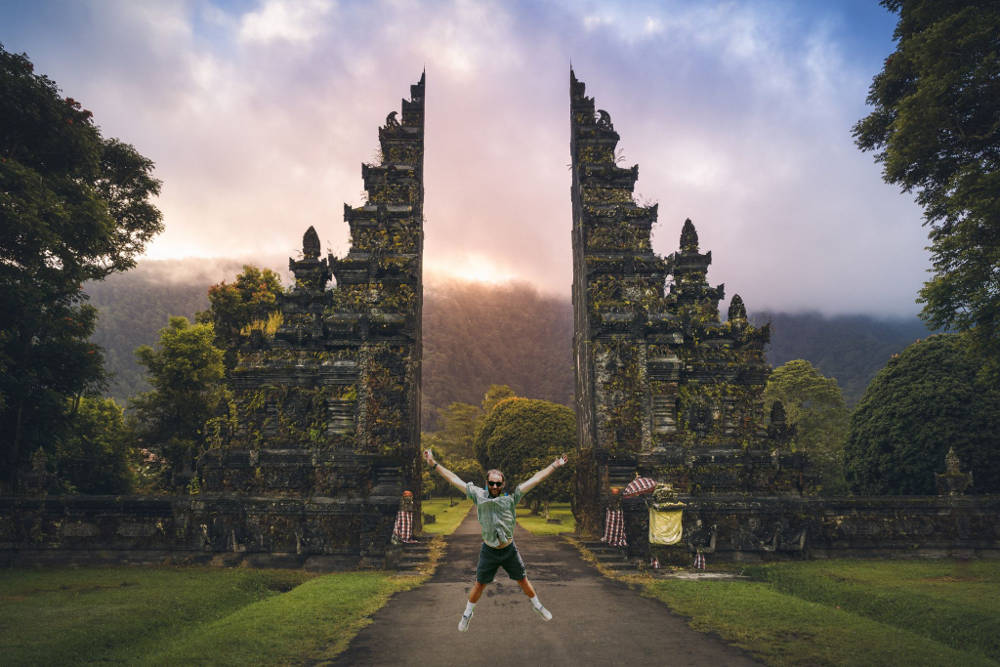 One of the main tourist attractions in Bali seems to be instagrammable photo ops. The roadside is littered with colorful signs to pose under, [albeit beautifully] woven hearts and nests, and swings galore. Never, however, was this photo-in-lieu-of-actual-culture made more apparent than today at the Handara Gate. One of the main tourist attractions in Bali seems to be instagrammable photo ops. The roadside is littered with colorful signs to pose under, [albeit beautifully] woven hearts and nests, and swings galore. Never, however, was this photo-in-lieu-of-actual-culture made more apparent than today at the Handara Gate.
Due to a series of circumstances too convoluted to get into, Della and I hired a private taxi for the day to take us to some sights and drop us off at a somewhat off the beaten path mountain town. Sights included UNESCO World Heritage rice fields (which were pretty magical), a temple on a lake and surrounding gardens (which felt a little like Disneyland, i.e. contrived for tourists but still kind of nice), and the Handara Gate (actually a gate to a golf course resort). The scene at the gates epitomized the it's-all-about-Instragram phenomenon that we can't help but sometimes feel overwhelmed by. You had to pay $3 and stand in line for 20+ minutes to get your photo op. And that's it. You never got a chance to actually admire the gate, since there was always someone posing there. There wasn't anything else there (unless you wanted to get in a quick 9). These hoards of people drove to this spot to stand in a line to get the photo and leave. But we weren't going to become one of them. We hopped back in our taxi (much to our driver's surprise) and were on our way. The gates are beautiful. And we understand the draw for sure. And if we pass by again when the line is shorter or we don't have a complicated situation with a taxi driver, maybe we'll join the masses. But at the moment, we couldn't bring ourselves to do it. So instead, I thought I'd Photoshop myself a nice little picture. So I cropped myself out of a jumper from earlier in the day, and badabinga: you can't hardly tell*. Pictures are a part of travel for sure. It's a great way to remember a place and a time. I cherish some of my travel selfies and look forward to taking many many more. But I hope that the next time I find myself lining up to get a picture in front of a faux cultural icon, I stop and take a moment to reflect. And then probably go post it on Instagram. |
| Monday January 20 2020 | File under: travel, indonesia |
| comment? |
| < Previous Page Next Page > |
| 1 2 3 4 5 6 7 30 31 32 33 34 35 36 |
Recent Comments:
*Horge on Mother Wrenger in the Nutcracker
*Horge on A Whirlwind Eclipse Adventure
*Andrew on A Whirlwind Eclipse Adventure
*Mom on A Whirlwind Eclipse Adventure
*Mom on Mother Wrenger in the Nutcracker
Recent Content:
*A Whirlwind Eclipse Adventure
*Mother Wrenger in the Nutcracker
*Malta Bene!
*2023 Performance Review
*Twas the Night 2023
*Recycled Plastic Christmas Ornaments
*Halloween Act 2023 - Dueling Banjos
*Walk Like MADD 2023
*New Stilting Costume
*Sleeping Around 2022-2023
*Project Hotdog Halfway Complete
*Giant Juggling Club
Websites du Friends:
* Wren the Juggler
My I-guess-I'm-a-Professional-Juggler juggling website
* Wren and Della
Della and my juggling website
* The Real Food Show
A circus-inspired elementary assembly show to teach kids about healthy eating
* Della Moustachella
Della's performance website
* The Fun Bags
Della and Sadye's Performance Troupe
Tags
Anacortes (39)
Cambodia (5)
China (14)
Korea (1)
Macau (1)
Mexico (13)
New Zealand (1)
Seattle (2)
Thailand (18)
USA (11)
Vietnam (5)
beard (5)
blog (8)
books (1)
coding (15)
comic (45)
contest (4)
environment (9)
events (12)
food (22)
games (15)
geocaching (4)
holidays (13)
juggling (8)
links (9)
meet-ups (1)
mexico (1)
misc (54)
movies (5)
open letter (2)
participation (1)
pics (39)
poetry (6)
poll (1)
quote (6)
road trip (25)
stats (1)
transportation (14)
travel (136)
video (6)
work (8)
*Horge on Mother Wrenger in the Nutcracker
*Horge on A Whirlwind Eclipse Adventure
*Andrew on A Whirlwind Eclipse Adventure
*Mom on A Whirlwind Eclipse Adventure
*Mom on Mother Wrenger in the Nutcracker
Recent Content:
*A Whirlwind Eclipse Adventure
*Mother Wrenger in the Nutcracker
*Malta Bene!
*2023 Performance Review
*Twas the Night 2023
*Recycled Plastic Christmas Ornaments
*Halloween Act 2023 - Dueling Banjos
*Walk Like MADD 2023
*New Stilting Costume
*Sleeping Around 2022-2023
*Project Hotdog Halfway Complete
*Giant Juggling Club
Websites du Friends:
* Wren the Juggler
My I-guess-I'm-a-Professional-Juggler juggling website
* Wren and Della
Della and my juggling website
* The Real Food Show
A circus-inspired elementary assembly show to teach kids about healthy eating
* Della Moustachella
Della's performance website
* The Fun Bags
Della and Sadye's Performance Troupe
Tags
Anacortes (39)
Cambodia (5)
China (14)
Korea (1)
Macau (1)
Mexico (13)
New Zealand (1)
Seattle (2)
Thailand (18)
USA (11)
Vietnam (5)
beard (5)
blog (8)
books (1)
coding (15)
comic (45)
contest (4)
environment (9)
events (12)
food (22)
games (15)
geocaching (4)
holidays (13)
juggling (8)
links (9)
meet-ups (1)
mexico (1)
misc (54)
movies (5)
open letter (2)
participation (1)
pics (39)
poetry (6)
poll (1)
quote (6)
road trip (25)
stats (1)
transportation (14)
travel (136)
video (6)
work (8)

